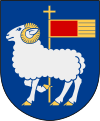Fårö
.jpg) Rauks at Langhammars, Fårö | |
 Fårö Gotland (Sweden) | |
| Geography | |
|---|---|
| Coordinates | 57°57′N 19°09′E / 57.950°N 19.150°ECoordinates: 57°57′N 19°09′E / 57.950°N 19.150°E |
| Adjacent bodies of water | Baltic Sea |
| Area | 113.30 km2 (43.75 sq mi)[1][2][3] |
| Administration | |
|
Sweden | |
| County | Gotland County |
| Municipality | Gotland Municipality |
| Demographics | |
| Population | 498 (2014)[1] |
Fårö (Swedish pronunciation: [ˈfoːˈrøː]) is a Baltic Sea island just off north of the island of Gotland, itself off mainland Sweden's southeastern coast. It is the second-largest island in the province and it is a popular summer resort. It has its own dialect (Faroymal, a dialect of Gutnish), claimed to be the oldest language in Sweden.[4] Formerly a socken which includes the Gotska Sandön island,[5] on 1 January 2016, it was reconstituted into the administrative area Fårö District.[6]
Geography

The island is separated from Gotland by the narrow Fårö-strait, and connected by two car ferries, operated by the Swedish Transport Administration. It has a total area of 111.35 square kilometres (42.99 square miles), of which 9.7 square kilometres (3.7 square miles) are water areas or islets.
On the islands of Fårö and Gotland are rock formations called "Rauk". They are a result of erosion during the Ice age and are unique to Gotland and Fårö.
The medival Fårö Church is on Fårö.[7]
One of the asteroids in the Asteroid belt, 9358 Fårö, is named after the island.[8]
Etymology
The name "Fårö" (in Gutnish "Faroy") is derived from the words "ö", meaning island, and "får-", which is a word associated with travel like in the Swedish word "färled" (fairway). The word Fårö probably means the island you have to travel to or the traveler's island. Mainland Swedes might misinterpret the name Fårö to be derived from får, the Swedish word for sheep, due to the many sheep on the island. However, the Gutnish word for sheep is "lamm" (similar to the Swedish word "lamm", meaning "lamb").
Military past
Until the 1990s, Fårö and the North of Gotland were off-limits to foreigners because of a government military installation there.[4] There were large, multilingual signs at the side of the roads informing visitors of this and the prohibition was strictly enforced. After the Cold War ended, the installation (Swedish coastal artillery division KA3) was mostly shut down. A relic of the island's military past is a 203 metres (666 ft) tall radio mast at Holmudden at 57°57'33" N and 19°20'46" E.
Cinematic heritage
Swedish filmmaker Ingmar Bergman lived and died on Fårö and several of his films were filmed there, among them Through a Glass Darkly (1961), Persona (1966), Hour of the Wolf (1968), Shame (1968), The Passion of Anna (1969), and Scenes from a Marriage (1972),[4] as well as Liv Ullmann’s Faithless (2000), based on a Bergman screenplay. The Bergman Week is a weeklong tribute to the filmmaker held on the island every June.[9]
Andrei Tarkovsky wanted to film The Sacrifice on Fårö but was denied access by the military. The Sacrifice was filmed further south on Gotland at När.
Tourism
An annual event on Fårö is "Fårönatta" (Fårö Nights), held in September, during which restaurants and bars stay open all night, craft stands are set up and the church holds a midnight Mass.[4]
Fårö districts

Digerhuvud
The Digerhuvud coast with Bjärge nature reserve is the largest stack area in Sweden, with hundreds of stacks along a 3.5 km (2.2 mi) part of the coast. Close by is the Helgumannen fishing village.[10][11] The coast is not suited for swimming due to its depth (up to 80 metres (260 feet) close to the shore), and its strong currents.
An asteroid in the Asteroid belt, 10102 Digerhuvud, is named after the area.[12]
Fårö Fyr (Fårö Lighthouse)
The Fårö Lighthouse lies on the island's northeastern point. It is 30 metres (98 feet) high and was built between 1846 and 1847.
Langhammars
The Langhammars peninsula and the Langhammars nature reserve on north-western Fårö are rocky beaches with Ice age stone monoliths known as rauks. Langhammars was the setting for Ingmar Bergman's film Through a Glass Darkly.[4]
Sudersand
The long, sandy Sudersand beach on north-eastern Fårö lies next to Sudersands Semesterby which rents cabins to tourists.
References
- 1 2 "Gotland i siffror 2015" [Gotland in numbers 2015]. www.gotland.se. Gotland Municipality. Retrieved 25 May 2016.
- ↑ "Statistisk årsbok 2011" (in Swedish). Statistics Sweden. p. 12. Archived from the original (PDF) on 5 July 2011. Retrieved 5 July 2011.
- ↑ Westrin, Th., ed. (908). "Fårö". Nordisk familjebok (9 (Uggleupplagan) ed.). p. 205.
- 1 2 3 4 5 Pergament, Danielle (7 October 2007). "The Enchanted Island That Bergman Called Home". The New York Times.
- ↑ The exact extent of the socken, now district, can be obtained by clicking on Kartinställningar and check the Socken box in the menu of this map from the Swedish National Heritage Board database.
- ↑ "Förordning om district" [Regulation of districts] (PDF). Ministry of Finance. 17 June 2015. Retrieved 24 May 2016.
- ↑ Lagerlöf, Erland; Svahnström, Gunnar (1973). Gotlands kyrkor [Gotland's Churces] (in Swedish). Stockholm: Rabén & Sjögren. p. 144. ISBN 91-29-41035-5. LIBRIS 7232718.
- ↑ "9358 Faro (1992 DN7)". NASA. Retrieved 6 June 2016.
- ↑ Peary, gerald. "For movie fans, an island getaway beckons". www.boston.com. The Boston Globe. Retrieved 17 June 2014.
- ↑ "Digerhuvud". www.gotland.net. Gotlands Media AB. Retrieved 6 June 2016.
- ↑ Enderborg, Bernt. "Helgumannen fiskeläge". www.guteinfo.com. Guteinfo. Retrieved 6 June 2016.
- ↑ "10102 Digerhuvud (1992 DA6)". NASA. Retrieved 6 June 2016.
External links
| Wikimedia Commons has media related to Fårö, Gotland. |
